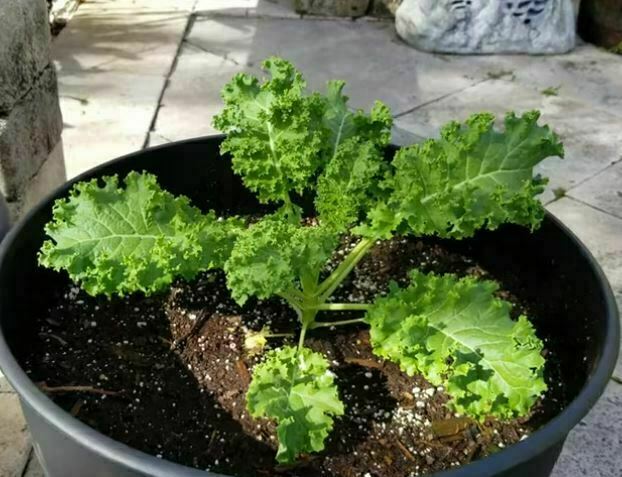Discover the simple steps to successfully growing kale indoors. Our guide makes indoor gardening easy, even for beginners.
Interested in kale and its bountiful health benefits, why not grow kale indoors and save yourself a trip to the grocery.
The great thing about kale is that you can perfectly grow it indoors all year round; this means you won’t have to wait to buy kale when you can have it available to yourself whenever you want to.
If you are wondering just how to achieve this, then you are in the right place because we’ll be covering everything you need to know on how to growing kale indoors.
Growing Kale Indoors – Quick Guide
- Decide how many kale plants you want and soak two or three seeds for each plant in water for 6 hours.
- Fill your tray or container with 3-4 inches of growing mix, moisten it with water.
- Plant the soaked seeds in the containers, about four inches apart, and cover them with a thin layer of growing mix until they’re 0.5 inches deep.
- Water the planted seeds enough to keep them wet but not overflowing.
- Keep the soil moist and the seeds in a warm place. Cover the containers with a plastic bag to create a suitable environment for germination.
- Once the seedlings are ready, prepare larger containers with drainage holes for transplanting.
- Fill the new containers with growing mix or potting soil.
- Gently remove each seedling from their original container and place them in the prepared holes in the new containers.
- Cover the roots with the mix and water them sufficiently. Regular watering is essential as they can dry out fast.
- Harvest the kale by picking the oldest and lowest leaves near the base of the plant while leaving the central and new leaves. Repeat this process weekly or as needed.
You may or may not be aware, but kale is a fantastic and super healthy vegetable; this powerhouse leafy green veggie is packed with nutrients and essential vitamins that are good for our bodies. Kale can help you in your weight loss journey, but not only that, it can keep cholesterol in check, protect you against cancer, improve your bone health and protect your eyes. There are also a variety of kale flowers.
Growing Kale Indoors – Types of Kale you can grow indoors
There are a lot of varieties of kale to choose from. Our Favorite Indoor Kale Plants include:
- Tuscan Kale – Lacinato: Also called “Dinosaur Kale,” this plant makes a lovely ornamental plant, and is also the kale for salad and is equally fantastic in soups. It presents a smoother texture, delicate flavor, and dark green color.
- Scotch Kale – Dwarf Blue Curled: Curly kale is the best type for making kale chips and is also a favorite for adding to smoothies. The compact size makes these plants well-suited to urban gardening.
Materials you need to growing kale indoors
Shopping list for growing kale indoors:
- Kale seeds or seedlings
- Potting soil (preferably organic)
- Containers or pots with drainage holes
- Grow lights or a sunny window sill
- Watering can
- Liquid organic fertilizer
- Temperature and humidity monitor
- Gardening gloves
- Trowel (for planting)
- Pruning shears (for harvesting)
Remember, each indoor environment can be unique so you may need to adjust your materials based on your specific conditions. Happy planting!
Growing Kale Indoors – Step by Step With Pictures
Growing kale plants is great for beginners and first-timer; anyone can do it. Follow a few simple steps, and you’ll surely succeed.
Prepping the soil and seeds

- First, you need to think about how many kale plants you want to grow; count out two or three seeds for each one.
- Put all the seeds in a little container full of water and soak for approximately 6 hours.
- Fill each tray part or container with 3–4 inches of the growing mix.
- Moisten the mix with a bit of water.
Plant the seeds

- Sprinkle two or three kale seeds in each of your seed containers. You can use a big container but remember to provide them with enough space, about four inches apart.
- Sprinkle a thin layer of growing mix over them until they’re 0.5 inches deep.
- Provide sufficient water to keep the seeds wet but be careful not to overflow.
Take care of the seeds

- Make sure to keep the soil moist enough for the roots to grow easily. Remember, the seeds don’t have a reliable root system for getting the water they need at this point.
- Kale seeds don’t need sunlight for germination, but keep them in a warm place and keep their soil moisturized. To create this environment, you can cover your containers or seed tray with a plastic bag.
Transplanting kale

If you want to speed up the growth of your seeds, this is an essential step.
- Prepare your containers with 12 to 16-inch-wide and equally tall drainage holes for each kale plant.
- Fill your containers with the growing mix or potting soil.
- Remove each seedling very gently from their containers without damaging their roots.
- Dig small holes for every seedling, and place their roots in them, and entirely cover their roots with the mix.
- Sprinkle or spray water on them to keep them moist. They can dry out fast, so don’t forget to water them.
Harvesting kale

- It is recommended to begin with the oldest and lowest leaves.
- Pick them near the base of the plant, one by one.
- Keep the central and new leaves.
- Do this every week or as needed.
Growing kale indoors – What is the best time to grow kale
You can grow kale all year round.
Spring: Start growing kale indoors in early spring, about a month before the last frost to harvest in summer or around the beginning of fall.
Summer: If you want kale for winter, plant 6 to 8 weeks before the first frost at the end of summer.
Fall: If you have a mild winter coming, start planting kale in the fall for a winter harvest.
Care of indoor kale
When caring for your indoor kale, you need to focus on two-three things; water, soil, and fertilizer.
Water: If you want your kale to grow sweet and crisp leaves, make sure you water your kale plants at their base and stop if water starts to overflow.
Soil: Kale plant prefers rich and acidic soil, with a pH between 6.0 to 7.5, and the right amount of nitrogen in the soil helps grow healthy leaves.
Fertilizer: A balanced 10-10-10 fertilizer is best for growing kale, meaning it has 10% nitrogen, 10% potassium, and 10% phosphate.
Kale’s pests and diseases
To protect your plants against pests, you can spray neem oil on your plants. If you see any cabbage worms on your crops, pick them or use bacterial insecticide sprays. Another good idea is to use companion plants to protect kale against pests.
Kale’s companion plants
Kale’s companion vegetables include beans, beets, peas, tomatoes, lima beans, hot peppers, potatoes, cucumbers, and carrots.
Kale also grows well with alliums like chives, garlic, and onions. It is also a good idea if you want to grow kale around herbs like dill, cilantro, catnip, sage, thyme, mint, and lemongrass.
Growing Kale Indoors FAQ
How long does it take for kale to grow?
It will take kale between 4 to 6 weeks to get about 10 inches tall and develop three or four leaves; this is the suitable time for transplanting them.
What’s the right temperature kale needs to grow?
The optimal temperature for growing kale indoors is 60–65°F, but the plants can germinate at 45°F to 85°F.
Does kale need sunlight to grow?
Kale grows in optimum condition when it gets abundant sunlight. However, it would help if you protected it against scorching hot weather. Once your plant begins to grow, make sure it gets 4–6 hours of sunlight every day.
When to harvest kale?
Kale can mature in about 30–40 days if transplanted; otherwise, you need 55–65 days. When you notice the leaves have the same size as your hands, it is a clear sign that you need to harvest.
How many days does it take to have baby kale?
You can expect to have baby kale in less than a month! In just 25 days, you can expect to see results, it takes about 10 days for the plants to germinate, and your seeds will sprout a few days after that.



